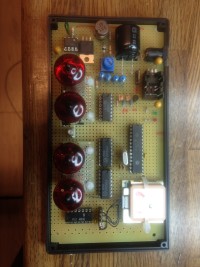Simple nixieclock [140013-I]

For sure: this is not a very original project: countless people designed a clock. Why another one? Well, this is a very compact clock built with 4 nixie tubes. It fits in a small box (17 x 9 cm) and the time is acquired with a GPS module, so no adjustment is needed. If there is any interest I will write a projectdescription.Buy the PCB and programmed controller in the Elektor shop:
For sure: this is not a very original project: countless people designed a clock. Why another one? Well, this is a very compact clock built with 4 nixie tubes. It fits in a small box (17 x 9 cm) and the time is acquired with a GPS module, so no adjustment is needed. If there is any interest I will write a projectdescription.
Buy the PCB and programmed controller in the Elektor shop:
http://www.elektor.com/search?cat=0&q=140013
Nixie tubes are obsolete, but there are still loads of them available (NOS and used) on Ebay, and of course there are (web)shops selling vintage electronic parts.



Discussion (10 comments)